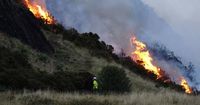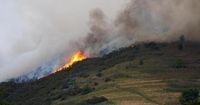Scotland is bracing for another week under the shadow of wildfire danger, as the Scottish Fire and Rescue Service (SFRS) issues its tenth wildfire warning of 2025. This latest alert, prompted by a dramatic blaze on Edinburgh’s iconic Arthur’s Seat, is a stark reminder of the growing threat posed by rising temperatures and human activity across the country.
The warning comes into effect on Wednesday, August 13, and will remain in place until Tuesday, August 19. It covers a broad swathe of the country, starting with eastern Scotland from August 13 to 15, then extending to both eastern and western regions over the weekend, and finally blanketing most of Scotland—including the central belt and southern uplands—on August 18 and 19. According to the SFRS, this is the tenth such alert this year, a frequency that underscores the severity of the current wildfire season.
The immediate catalyst for this heightened state of alert was a large gorse fire that erupted on Arthur’s Seat, the extinct volcano that looms over Edinburgh, on Sunday, August 10. Fire crews battled the blaze well into the early hours of Monday, mobilizing four appliances and specialist resources to tackle the flames. The fire engulfed significant portions of the hill, sending plumes of smoke over the city. Thankfully, no casualties have been reported, but the incident has left a visible scar on one of Scotland’s most treasured landmarks.
Arthur’s Seat is just the latest in a string of locations to suffer from wildfires this year. According to BBC and other local outlets, areas as diverse as Carrbridge and Dava in the Highlands, Perthshire, Arran, Thurso, Cumbernauld, and the Pentland Hills have all experienced significant blazes since April. In particular, the fires in Carrbridge and Dava were described by Scottish Land and Estates as the largest ever seen in Scotland, highlighting the unprecedented scale of the problem in 2025.
What’s driving this surge in wildfires? The answer, it seems, is a combination of sizzling summer weather and human behavior. The Met Office has forecasted highs of up to 28°C in some regions over the coming days, with the Highlands and Moray expected to reach at least 25°C on Wednesday. These dry, hot conditions create a tinderbox environment, making it dangerously easy for fires to ignite and spread rapidly.
But it’s not just the weather. SFRS group commander Niall MacLennan has been unequivocal in pointing to human activity as the primary culprit. “During periods when the risk of wildfires is high, we want people to avoid using portable barbecues, discarding cigarettes on the ground or lighting campfires in or near areas of vegetation, as these all pose a significant threat,” MacLennan said, as reported by The Press and Journal and other sources. “We know the vast majority of wildfires are started by human behaviour, so acting responsibly can lower the chance of a fire starting in the first place.”
MacLennan’s message is not just about prevention, but also about protecting Scotland’s remote and rural communities, which can be especially vulnerable to the impacts of wildfires. “Help us protect remote and rural communities, who can be hugely impacted by wildfires, by following the safety advice and being familiar with the Scottish Outdoor Access Code,” he urged. The SFRS has made wildfire prevention and safety advice available on its website, and the Scottish Outdoor Access Code offers further guidance for those venturing into the countryside during this risky period.
The consequences of these fires go beyond the immediate danger to people and property. Wildfires have the potential to burn for days, devastating vast areas of land and wildlife. The Glen Rosa fire on the Isle of Arran in April, for example, destroyed significant stretches of moorland, while the Dava Moor blaze in the Highlands was among the worst in recent memory. These incidents have left behind charred landscapes and disrupted local ecosystems, underscoring the long-term environmental cost of such events.
Firefighters and emergency services have been stretched thin by the ongoing crisis. At Arthur’s Seat, crews worked tirelessly to contain the flames, deploying multiple appliances and specialist teams. Their efforts have been widely praised, but the sheer number of incidents—ten major wildfire alerts in just eight months—has put a strain on resources and highlighted the need for greater public vigilance.
The SFRS’s advice for the coming week is clear and direct. Communities are being asked to avoid lighting fires and using naked flames outdoors. Portable barbecues, discarded cigarettes, and campfires in or near areas of vegetation are all singled out as significant risks. “Acting responsibly can lower the chance of a fire starting in the first place,” MacLennan reiterated, echoing a message that has been repeated throughout the summer.
For those looking to enjoy Scotland’s natural beauty during the heatwave, the advice is to do so with caution and respect for the land. The Scottish Outdoor Access Code is an essential resource, offering practical tips on how to minimize the risk of starting a wildfire and what to do in the event of an emergency. The SFRS website also provides up-to-date information on current risks and safety measures.
As the heatwave continues, there’s a sense of urgency in the air. The combination of high temperatures, dry conditions, and human activity has created a perfect storm for wildfires. The SFRS’s repeated warnings—now a regular feature of the Scottish summer—reflect a new reality for the country, one where the risk of wildfire is ever-present and demands constant vigilance.
Looking ahead, the hope is that increased awareness and responsible behavior will help stem the tide of wildfires. The public’s role is crucial; by following the advice of fire chiefs and respecting the environment, everyone can play a part in protecting Scotland’s landscapes and communities from further harm.
For now, as Scotland enters another week of “very high” wildfire risk, the message from authorities is simple: enjoy the sunshine, but do so safely. The country’s firefighters—and its fragile natural heritage—are counting on it.

